Tackling Open Defecation and Improved Sanitation in Developing Countries: A Toilet Talk from the State of Bihar, India
Sandeep Kumar Sinha  and Pradeep Chaudhry
and Pradeep Chaudhry 
1Indian Institute of Forest Management, Research institution, Bhopal, Madhya Pradesh, India .
DOI: http://dx.doi.org/10.12944/CRJSSH.2.1.06
Copy the following to cite this article:
Sinha S. K. 2018 Tackling Open Defecation and Improved Sanitation in Developing Countries: A Toilet Talk from the State of Bihar, India. Current Research Journal of Social Sciences and Humanities 2(1). DOI:http://dx.doi.org/10.12944/CRJSSH.2.1.06
Copy the following to cite this URL:
Sinha S. K. 2018 Tackling Open Defecation and Improved Sanitation in Developing Countries: A Toilet Talk from the State of Bihar, India. Current Research Journal of Social Sciences and Humanities 2(1). Available From: https://bit.ly/30yr7LI
Download article (pdf) Citation Manager Review / Publish History
Select type of program for download
| Endnote EndNote format (Mac & Win) | |
| Reference Manager Ris format (Win only) | |
| Procite Ris format (Win only) | |
| Medlars Format | |
| RefWorks Format RefWorks format (Mac & Win) | |
| BibTex Format BibTex format (Mac & Win) |
Article Review / Publishing History
| Received: | 21-12-2018 | |
|---|---|---|
| Accepted: | 28-02-2019 | |
| Reviewed by: | Ahmed Karmaoui | |
| Second Review by: | Vachaspati Shukla | |
| Final Approval by: | Dr. Diptendu Chatterjee | |
Introduction
Notwithstanding its remarkable technological progress especially in telecommunication and satellite launching sector, the progress on the front of eliminating open defecation is not up to the mark in India. With 67% of rural households and 13% of urban households defecating in the open,1 India reports for 60% of the world’s open defecation, with two-thirds of its population living with unimproved sanitation and an estimated 600 million people defecating outside.2 Talking in international terms, % open defecation (OD) in India is a way more than many of the poorest countries of the world including the Democratic Republic of the Congo, Malawi, Burundi, and Rwanda. Countries like Myanmar, Uganda, Bangladesh, Gambia and Cameroon where GDP/capita is much lower than India, % OD is in single digit in comparison to India’s 48%.3
There has been a stark difference in Government of India’s data, as per the progress reported by the Ministry of Drinking Water and Sanitation in 2014, 76 per cent of families have sanitation facilities in rural areas. They also pronounce this a very energetic and encouraging achievement which also results with the introduction of Nirmal Gram Purushkar (NGP). Ministry said that there has been an exponential increase in the coverage of the toilet facility. During the decade (2001-10), the figures accelerate and reach up to 65 percent4. In contrast to these encouraging figures, numbers released by the population census in 2011 came up with the very grim picture as far as rural India is concerned, this study shows that only 30 per cent of rural families have access to sanitation facilities as of 65 per cent in 2010 released by the Ministry.
Open defecation has been defined as the practice when people choose to defecate outside in open spaces such as agricultural fields, open bodies of water, agricultural fields, urban parks, river and canal sides, near railway tracks among other open spaces instead of using toilets. This issue has been a major problem in WASH domain in developing countries. The practice of OD leads to public health problems in areas where people defecate in areas proximal to the living space of others. Public sanitation and India’s lack of toilets became a prominent theme in the 2014 general elections. During the last election campaign, the prime minister of India argued that toilets should be prioritized over temples (pehleshauchalaya, phirdevalaya). Later on, delivering his first Independence Day speech in 2015 from Red Fort, he mentioned “We are in the 21st century”, “Have we ever been pained by the fact that even today our mothers and sisters have to defecate in the open? The dignity of women... isn’t this a responsibility of everyone?”5Open defecation remains as tub born public health concern in the country even now.6,7,
India lags far behind as compared to its neighbouring countries including Nepal, Bangladesh, and Pakistan. According to a report prepared by UNICEF which gives us food for thought in the last two decades (1990-2012), the study reflects the proportion of people going for open defecation witnesses slower pace, 86 per cent of incidence in Nepal were using open defecation in 1990 higher than India showed exceptionally improvement in 2012 which reduced to just 40 %. Performance of India is more disappointing pronounced when it has a sound economic growth and the government regime of the largest democracy in the world.9
In October 2014, Indian Prime Minister Narendra Modi inaugurated the Swachh Bharat Mission10 to eliminate open defecation (OD) by 2019. To encounter the problem two major changes must take place:
- Increase in the number of households that have latrines;
- Increase in the number of household members using those latrines.
As the problem lies in the fact that even after the availability of toilets, the behavioral pattern of usage is open defecation for which we need extra efforts to convince people to make use of available toilets. Therefore, behavioural change is critical in addition to the provision of toilets. The factors responsible for preferential usage of open defecation can be traditional/cultural practices or lack of accessibility to newly built toilets, or both. Why do people in rural India defecate in the open in such large numbers? To answer this question, it requires understanding the behavioural psychology of the people. We asked 653 rural households in two districts of Bihar state of India. While interviewing the households, we tried to assess the change in their behaviour with respect to Swachh Bharat Mission (SBM) as well as their current behaviour to adopt healthy sanitation practices. Therefore, the purpose of the study was to assess the change in the behaviour of the community and obtaining objectively consistent conclusions that could be further used in decision-making under SBM.
We noticed that out of 443 households who own toilets, 96 of them prefer going outside which means still more than one-fifth of this category households are going for OD. They do so because of many reasons (Figure 5). The findings of this study unveilinclination for open defecation in the state and simply by providing “access” to toilets without jolting the behaviour of people is unlikely to reduce the practice of open defecation. The present study suggests that absence of toilet infrastructure is not only the primary or sole factor for continued open defecation but constructing toilets was also not going to solve the problem of open defecation in rural Bihar as the mindset of rural people needs to be changed. Poor quality and an inappropriate toilet design of most of these toilets under Government sanitation schemes are also among major factors contributing a lot in rural people’s disinterest in these toilets.
Open Defecation and Behavioral Change: with special reference to Bihar
The Swachh Bharat Mission’s baseline survey report of 2012 named Bihar as the state has the worst sanitation figures as it stood at 78%. It was understood that an innovative approach is required to eliminate open defecation under the umbrella of Swachh Bharat Mission framework and to work efficiently in a state like Bihar. To achieve the main objective of Swachh Bharat Mission, ‘Sanitation for all’ has been the core agenda of Government of Bihar (GOB) and under this domain, GOB started Lohiya Swachh Bihar Abhiyan (LSBA)11 to cater to the families who were not covered under any other previous programs or Government schemes. Bihar is the first state where sustainable sanitation practices have been adopted and the same is extended to all the rural families under Swachh Bharat Mission- Gramin (SBM-G). However, the situation is very pathetic as not even 30% of sanitation coverage is found in Bihar which stood at last in the ladder while Sikkim is on the top among all Indian states (Figure 1).
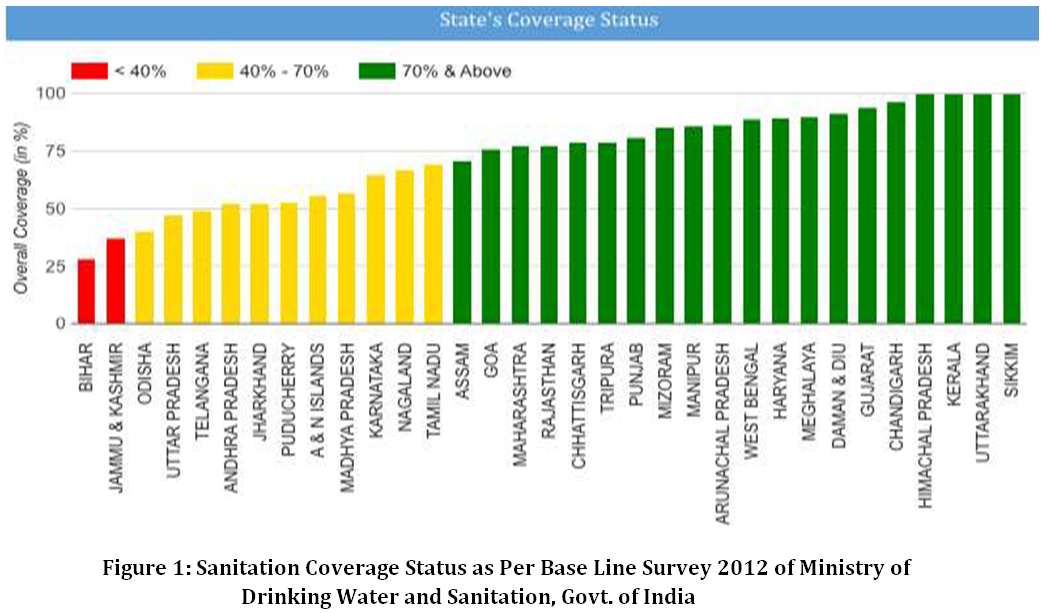 |
Figure 1: Sanitation Coverage Status as Per Base Line Survey 2012 of Ministry of Drinking Water and Sanitation, Govt. of India. Click here to view Figure |
Among the various states in the country, figures show very low coverage in eight low-income states with Bihar (2.6%), Jharkhand (3.7%) and Assam (6.8%) being the lowest in comparison to the other states of India. These States also fare low in terms of household and environmental sanitation with only 7.6% households having access to household toilets in Jharkhand, 17.6% in Bihar and 21.7% in Uttar Pradesh (UP) (Census, 2011). It is in this context that Government of India (GoI) proposed to implement a Rural Water and Sanitation Project with the first phase covering four states – Assam, Bihar, Jharkhand and UP.12 Lack of sanitation facilities not only vary within the neighboring countries but also in some cases interstate difference is predominant,13 the states who fall below the national average coverage of toilet facilities comprises of Jharkhand, Madhya Pradesh, Odisha, Chhattisgarh, Bihar, Rajasthan, Uttar Pradesh, Tamil Nadu and Karnataka (Table 1). All these states show a common pattern of poor economic states except Tamil Nadu and Karnataka, which is more surprising to be in this list as both are amongst the high-income states of India. Moreover, Census 2011 also says that more people have access to television and telephones than the toilet facility available in India.
Table 1: Access to Household in the Worst Performing States.
|
Rank (worst as 1) |
State |
Percentage of Households in terms of Toilet Facilities |
Percentage of Households in terms of Radio |
Percentage of Households in terms of Television |
Percentage of Households in terms of Telephone |
|
1 |
Jharkhand |
7.6 |
17.3 |
13.7 |
38.7 |
|
2 |
Madhya Pradesh |
13.1 |
13 |
18.6 |
36.4 |
|
3 |
Odisha |
14.1 |
10.6 |
19.4 |
33.6 |
|
4 |
Chhattisgarh |
14.5 |
9.5 |
21.1 |
21.2 |
|
5 |
Bihar |
17.6 |
25.8 |
10.2 |
53.5 |
|
6 |
Rajasthan |
19.6 |
13.9 |
25.6 |
66.2 |
|
7 |
Uttar Pradesh |
21.8 |
25 |
23.5 |
63.6 |
|
8 |
Tamil Nadu |
23.2 |
18.7 |
85.3 |
66.3 |
|
9 |
Karnataka |
28.4 |
17.6 |
46.3 |
62.6 |
|
10 |
Andhra Pradesh |
32.2 |
6.1 |
49.3 |
54.8 |
Sampling Strategy
We surveyed and interviewed 653 households in two districts of Bihar i.e. Gopalganj and Bhagalpur. Because our study focused on defecation behaviour of households, a cross-sectional study was undertaken because it was a type of observational study that analyzed data collected from a population.
Our survey used a four-staged sampling strategy to select households.
- Districts: Districts were chosen randomly from the list of Open defecation-declared districts as per the SBM website. We have taken those districts into consideration where a significant change in the rural open defecation was there between the 2001 and 2011 census.
- Blocks: Six blocks were chosen randomly from the two districts where maximum construction of toilets had taken place under Government schemes.
- Gram Panchayats: Thirteen-gram panchayats were selected based on purposive sampling from the identified blocks. Approximately 50% of the wards were surveyed and, in each ward, a minimum of 10 households was considered. Care was taken to involve vulnerable groups, which included widows, physically disabled persons, refugees and efforts were made to maintain a representation of each social community present in the area.
- Households: The selection of ten households was done using a similar in-field randomization technique to avoid any biasness. We attempted to interview every sixth household from the centre point of the ward. We asked questions from the elder person from the household in Hindi using the KOBO toolbox app which was used to collect data while interviewing households. The average duration of the interview was about 20 minutes. The interview schedule was specially designed after doing some preliminary visits. The interview schedule consisted of questions ranging from the presence, access, and usage of toilets. We also physically verified the technology of toilet pits, availability of soap/detergent near the toilet, cleanliness etc which could be the indicator of behavioural change.
Results and Discussion
More than 50 % of the rural households in Bhagalpur district were not found having toilet facility, whereas about 45 % were having toilet facility (Figure 2). The situation was comparatively better in Gopalganj district where about 85 % of rural households were having the toilet facility (Figure 3).
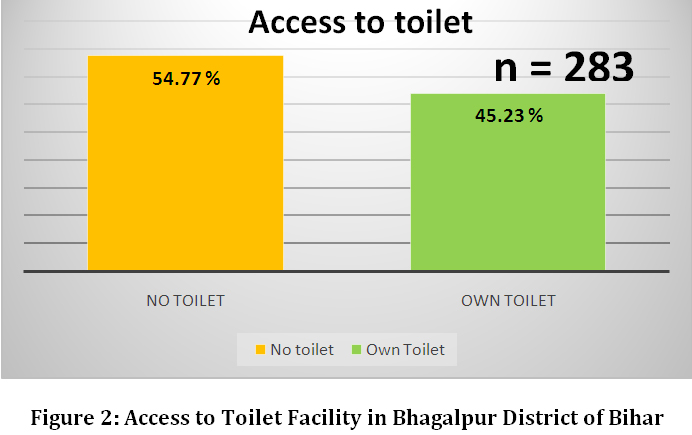 |
Figure 2: Access to Toilet Facility in Bhagalpur District of Bihar. Click here to view Figure |
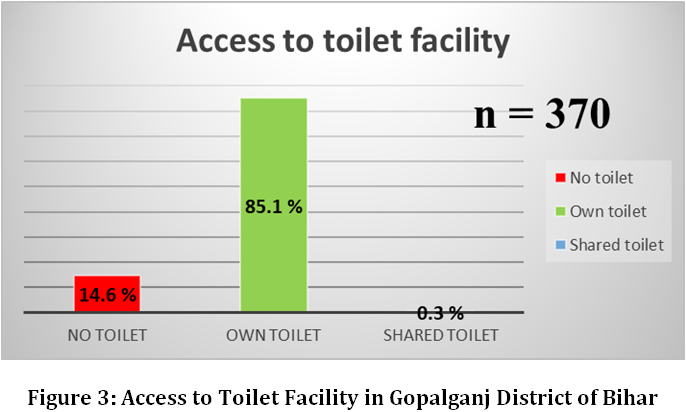 |
Figure 3: Access to Toilet Facility in Gopalganj District of Bihar. Click here to view Figure |
We devoted our study on five different aspects of sanitation, toilet construction, and usages. First one relates to barriers and key challenges of achieving open defecation free (ODF) objectives. Second, the relation between subsidy and sanitation coverage. Third, what were the key factors in some Gram Panchayats (GPs) where sustained behavioural change has been seen. Fourth, how Information, Education, and Communication/Interpersonal communication (IEC/IPC)can bring sustained behavioural change. The last aspect which has been observed are preference, beliefs, and perception of respondents regarding open defecation and the use of available toilets.
In rural India, many people who live in a house that owns a toilet constructed by themselves nevertheless defecate in the open. We asked about usual sanitation behaviour from each adult person in the surveyed household. For most of the old aged people, open defecation was increasing with age. This probably reflects two factors. First, on an average older people can move more freely outside their homes to enact their preferences. Second, they are a member of earlier cohorts, born in the times when open defecation was practiced without any stigma attached to it and was acceptable.
Barriers and Key Challenges in Achieving ODF Objectives
The absence of toilet infrastructure is not an isolated factor for the continued practice of open defecation thus construction of it will not be going to entirely solve the problem. Poor quality and inappropriately designed toilets were made available to rural households by different stakeholders under Government sanitation schemes. Different layers of the Government system were found not working in cohesion to address the ground realities in an efficient manner. The consequences perceived were mainly related to the lack of proper knowledge among the villagers, the political set up putting up negative impact on the local people and the incentive disbursal which has on one side created a helping hand to the local people but on the other side made them dependent on the government subsidies and thus creating an obstacle for the behavioral change among the people. There are other behavioural aspects, which stop the people to adopt and use toilets. These aspects vary with demographics, castes, different age groups and across genders. A large no. of people who seemed to be well established and with proper infrastructure too lacked toilets at their home, which shows that toilets were not important for them. Most of the people are not able to realize the priority of toilets in their daily life and give importance to other amenities such as marriage ceremonies, buying vehicles, costly household items etc. if some money is available with them.
The Relation between Subsidy and Sanitation Coverage
Media in the country often emphasizes the need for the government to provide “access” to sanitation. In contrast to the message conveyed through media, it has been found in the present study that the use of toilets is higher among the households which have built the toilets on their own in comparison to the HHs whose toilets were constructed with the help of government incentive. People in rural areas think that toilet was a very expensive asset costing more than Rs.21,000 whereas Govt. incentive was only Rs. 12,000. Swacchh Bharat Mission Gramin adopted CLTS (Community-led Total Sanitation) model where the community is leading the campaign towards total sanitation and if it is community driven then there should not be the need of subsidy.
Key factors in some Gram Panchayats where sustained behavioural change has been seen
Key factors, which played an important role in sustaining and achieving Open Defecation Free (ODF) status, are the involvement of Panchayati Raj Institutions (PRIs), local administration and the other stakeholder's support. Gram Panchayats (GPs) like Bari Rai Bhan, Jigna Jagarnath, Bideshi tola and Barari Jagdish in Gopalganj district are good examples to learn and understand the factors, which support to achieve the ODF status (Table 2). It was observed that Mukhiya played an important role in influencing and motivating the community and made them understand about the cleanliness. Nevertheless, with the support of ward members, CLTS motivators, Nigraani Samiti (Care committees) they were capable enough to understand the community. The other reason we found that education level of people and children was good. Well, the drainage system was found in the above-mentioned panchayats, which shows that people were self-motivated. People have a basic idea of what sanitation is and how do they practice the basic hygienic processes. They actively used the toilets and created peer pressure on the people around them so that everyone in the community had their personal toilets. The construction materials used were very good in quality. There was no such Politics in terms of hampering anyone’s rights in the GP. As we could see that the Mukhiya was supportive and helped everyone to build his or her toilets and in case someone needed any kind of any financial assistance, he was ready to give that too.
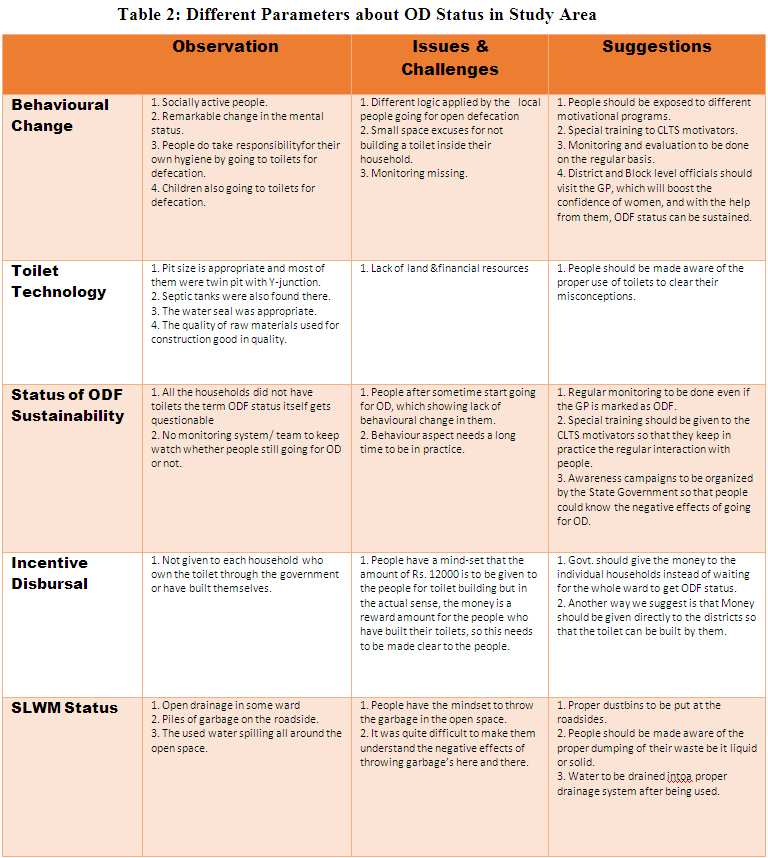 |
Table 2: Different Parameters about OD Status in Study Area. Click here to view Table |
How IEC/BCC (Information, Education and communication/ Behavior change communication) can bring sustained behavioural change?
Outreach and communication both play a vital role in the success of any national program. Therefore, it is a very essential part of any program which ensures that the right information is given to the right people at the right time. To nudge the rural population of Bihar towards safe sanitation practices and to make them understand the dire consequences of open defecation, SBM formulated unique communication tools under IEC activities e.g. posters, brochures and street play helping the communities and the people to think wisely and come along the way to change the situation. IEC channels include inter-personal communication such as individual discussion, community meetings, and events. It may also include mass media communication such as radio, television and other forms of one-way communication like advertisements.
The government has been working towards providing subsidy support to construct toilets, but the study found that many people are not accepting the toilets because of various reasons. Government is very much focused on to increase the coverage of toilets in rural India rather the demand of the hour is to increase the usage of the toilet. In our survey, over 32% of households who do not have toilet cite numerous reasons as to why they were not interested in them and were much happy to defecate in the open. Some people responded that due to lack of enough land they were unable to build their own toilets. Some households also cited that their family doesn’t come under the baseline survey 2012, due to which they did not get the benefit of the subsidy from SBM (Figure 4)
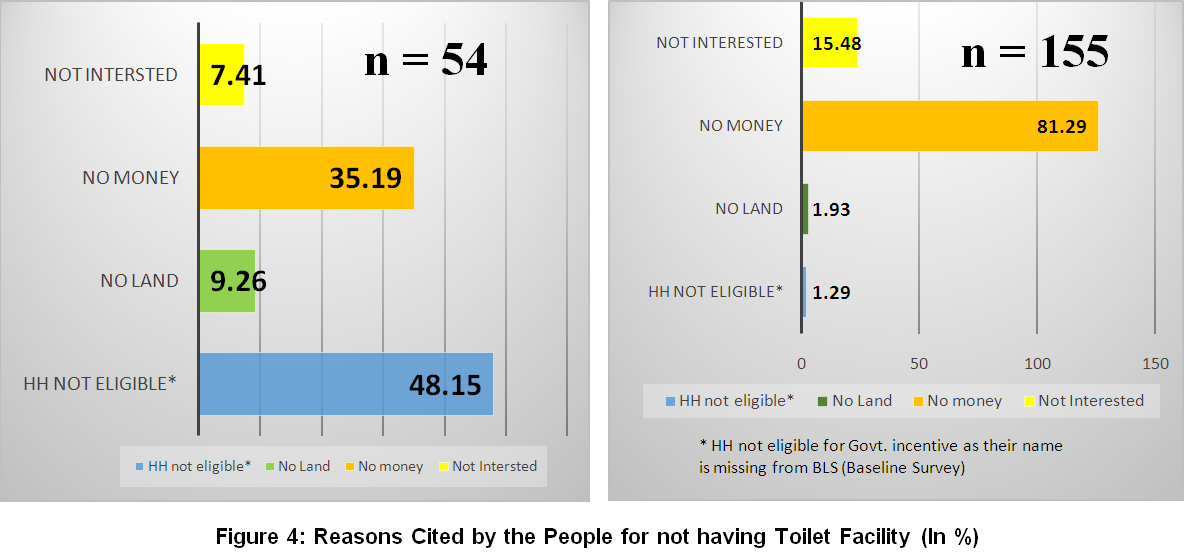 |
Figure 4: Reasons Cited by the People for Not Having Toilet Facility (In %) Click here to view Figure |
It was found that over 20% of people defecate in open even though they own a toilet. We identified five common reasons why these people defecate in the open, a majority of these numbers defecate in the open because of the poor construction of toilets (Figure 5).
 |
Figure 5: Reasons Cited by the People for Not Using Toilet Facility (In %) Click here to view Figure |
With the help of local authority and Panchayati Raj Institution (PRIs)members, some contractors were involved in the construction of toilets because many people couldn’t afford to construct toilets on their own, hence the role of such contractors came into the picture. They got the signatures of the households that when they will get the subsidy of Rs. 12,000 from Government, they will hand over to the contractors. Because of the involvement of such kinds of greedy contractors, the raw material used to build toilets was very inferior in quality and at many places we observed incorrect or inappropriate technology was being used, just to increase the coverage of sanitation (Figure 6).
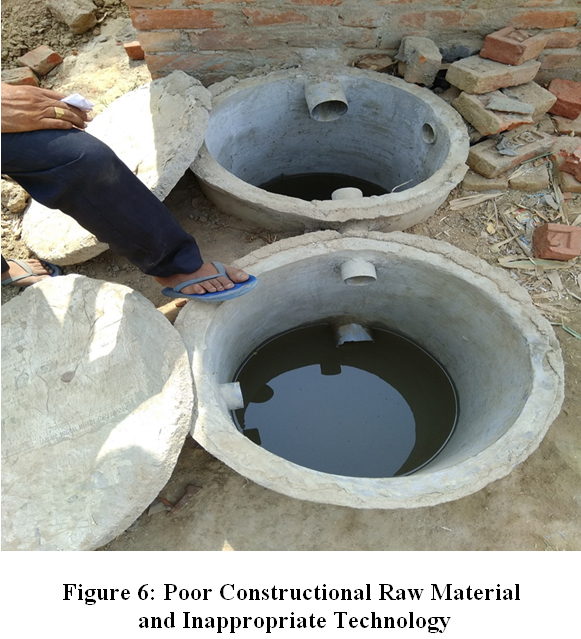 |
Figure 6: Poor Constructional Raw Material and Inappropriate Technology. Click here to view Figure |
Because of the lack of knowledge and inadequate information, it was noticed that people tend to build a single pit toilet, instead of double pit toilets. A double pit toilet is a right technology and sustainable as far as the rural setting was concerned. Because of the design of the pan, it consumes less water in drought-prone rural areas of the state. By inspecting different kinds of toilets which are being built and by observing the tinges and erratic behaviour of the people in the study area, we observed that a large fraction of people in rural Bihar still prefers defecating in the open. We asked various open-ended questions, where households cited their preference to go outside because it was more pleasure in the open air and in this way, they get some leisure time to talk to their tribe and can discuss local and political issues. Similar kinds of observation were also noticed by Coffey et al., (2014)3 during their study in five northern and central Indian states.
When we asked the same question to old people, they responded that how can they go to the same toilet which their daughter-in-law was using? This kind of orthodox behaviour pushes the usage of the toilet in the back seat. Even some of the educated mass revealed that double pit toilet is just like use and throw and it could not be useful in the long run. Some of the households have started using these toilets as storerooms (Figure 7).
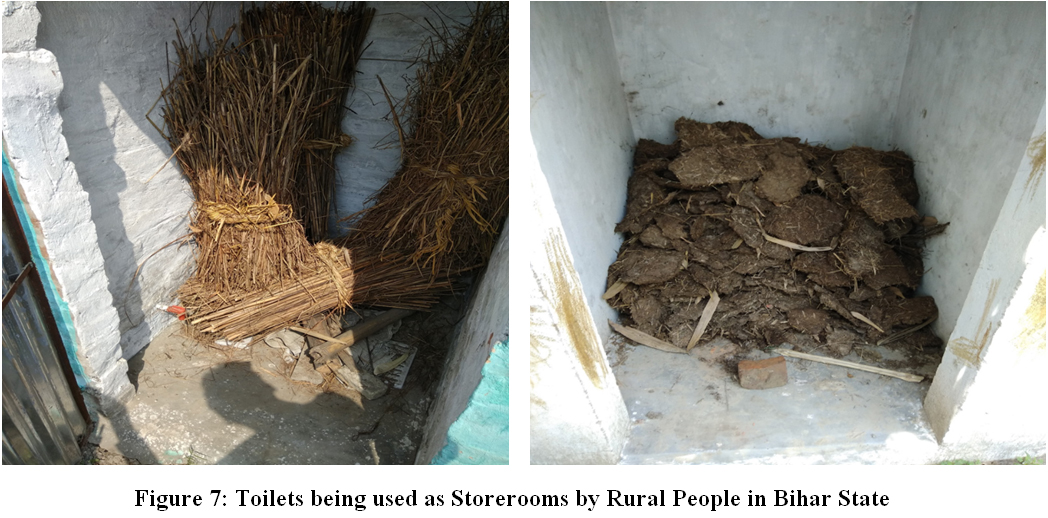 |
Figure 7: Toilets being used as Storerooms by Rural People in Bihar State. Click here to view Figure |
O’Reilly and Louis (2014)14 came out with toilet tripod framework where three legs of the tripod have to be equally strong for successful sanitation program i.e. (1) multi-scalar political will on the part of both governmental and non-governmental organizations (NGOs),(2) proximate social pressure, i.e., person-to-person contact between rural inhabitants with their neighbors, and with toilets and (3) political ecology, specifically, changing land use, assured access to water, and compatible soil type. In our study, this concept was more prominent in the case of Gopalganj district than Bhagalpur district, thereby comparative success rate of toilet construction and usage was higher in Gopalganj district. McMichael (2017)15 successfully applied this concept in her study related to eight wards in Kotgaun village development committee of Nepal.
Conclusion
Despite the nation’s economic development, the government’s attempt in toilet construction and increasing the acceptance of the policy, open defecation remains rooted widespread in rural India. The Indian Government’s attempt to reduce open defecation by providing subsidies for construction of toilets have not been largely effective in addressing the root cause of the problem. It is now clear that the behaviour change of rural people must be the priority if progress on ending open defecation is to be made.16 During the examination and observation of the types of toilets that are being built and the behaviour of individuals within the household for its usage, it was found that many people still prefer open defecation. Respondents explained that there were many pleasant advantages of open defecation and that using a toilet was probably no healthier than going outside. Those people who defecate in the open, majority comes from the old age group who responded that defecation in open was pleasurable, comfortable, and convenient. Many respondents replied that defecating in the open offers them a chance to take a morning walk, on the way they are also able to see their agricultural fields and inhale morning fresh air. Coffey et al., (2014)3 has rightly described the widespread open defecation in rural India as a unique human development emergency. Rural India’s triple challenge model in the form of three intersecting circles of high population density, widespread open defecation and low demand for latrine use as described by Coffey et al., 2014,3 is fully applicable in the state of Bihar. Bihar state ranked 3rd in human population in the country and each year when figures are recomputed, it has been revealed that large fraction of people defecate in the open, which carries the risk of an increase in the cost for health and human capital of open defecation. India’s performance in making the country open defecation free is far from satisfactory, particularly when contrasted against neighbouring countries like Nepal and Bangladesh, which have fared far better despite being poor nations in terms of per capita income (Shukla 2016).9 According to the author, increases in the number of households without toilet facility (between 2001 to 2011) is indicative of big policy failure.
School children-led total sanitation (SLTS) campaign has been very successful in the neighboring country like Nepal and has helped them to have toilets in every household without any incentive given to them.17 From our study, it was seen that the children were actively participating in different campaigns and can be the best ambassadors in this movement. We suggest that SLTS model could be helpful in designing the framework of sustaining the practice of healthy sanitation activities. Moreover, every Indian state, not only Bihar, should use their livelihood missions to reach out to the women as they are the most important part of the society who are self-motivated towards this mission and this will ensure toilets in every household of SHG (Self-help group). The state should aim for “ODF SHG’s” i.e. open defecation free self-help group and should add a provision for ODF SHG entry in LSBA activities and website with a special reference.
Funding Source
The study was funded and assisted by the Bihar Rural Livelihood Promotion Society (JEEViKA).18 Government of Bihar.
Acknowledgments
The opinions expressed herein are those of the authors and do not necessarily reflect the views of JEEViKA. The authors express their gratitude to Ms. Pragya Ashanaand Mr. Aditya Raj, Xavier Institute of Social Service, Ranchi who helped a lot in primary data collection. The authors are highly indebted to the District Magistrates, Block Development Officers and all the associated local Panchayati Raj Institution members for providing valuable information, without which the study could not have been completed.
References
- Census India (2011): Accessed at http://censusindia.gov.in/
- WHO and UNICEF (2014): UNICEF Joint Monitoring Program Database, http://www.wssinfo.org/
- Coffey D., Gupta A., Hathi P., Khurana N., Speras D., Srivastav N and Vyas S (2014) Revealed Preference for Open Defecation: Evidence from a new survey in rural north India. Economic & Political Weekly. Vol XLIX (38): 43-55.
- Progress on Drinking Water and Sanitation 2014, WHO and UNICEF; Accessed at https://www.unicef.org/publications/index_73448.html
- Doron A and Jeffrey R (2014): Open defecation in India. Economic & Political Weekly. 299XLIX (49): 72-78
- Sahoo K. C., Hulland K. R. S., Caruso B. A., Swain R., Freeman M. C., Panigrahi P Dreibelbis R (2015): Sanitation-related psychosocial stress: A grounded theory study of women across the life-course in Odisha, India. Social Science and Medicine, 139:80-89
CrossRef - Spears D., Ghosh A and Cumming O (2013): Correction: Open defecation and childhood stunting in India: An ecological analysis of new data from 112 districts. PloS one, 8(9). https://doi.org/10.1371/annotation/9ffcb740-f394-41af-bbbc-800c7cc25ea8
CrossRef - O’Reilly K., Dhanju R., and Goel A. (2017): Exploring “the remote” and “the rural”:
Open defecation and latrine use in Uttarakhand, India. World Development 93:193–205 - Shukla V. (2016). Assessing India’s Progress towards an Open Defecation Free Nation. Journal of Infrastructure Development, 8 (1), 85-91.
CrossRef - Swachh Bharat Mission (2014): Accessed at https://swachhbharat.mygov.in/
- Lohiya Swachh Bihar Abhiyan: Accessed at https://lsba.bih.nic.in/
- BSWSM (Bihar State Water & Sanitation Mission, Government of Bihar): 2012.
Accessed at: http://www.bswsmpatna.org/spmu.html - Mishra U.S., & Shukla V.(2015). Provision of Basic Household Amenities in India: A Progress Report, Social Change 45 (3), 1-19.
- O’Reilly, K and Louis E (2014): The toilet tripod: Understanding successful sanitation in rural India. Health & Place. 29:43-51
CrossRef - McMichael C (2017): Toilet talk: Eliminating open defecation and improved sanitation in Nepal. Medical Anthropology. DOI: 10.1080/01459740.2017.1371150
CrossRef - Hathi P., Spears D and Coffey D (2016): Can collective action strategies motivate behavior change to reduce open defecation in rural India? Waterlines. 35(2): DOI: 10.3362/1756-3488.2016.011
CrossRef - Bell B (2010): Analysis of school-led total sanitation in Chitwan, Nepal, UN-habitat. Internship research report, UN-HABITAT & Utrecht University
- Bihar Rural Livelihoods Promotion Society: Accessed at http://brlp.in/

This work is licensed under a Creative Commons Attribution 4.0 International License.




